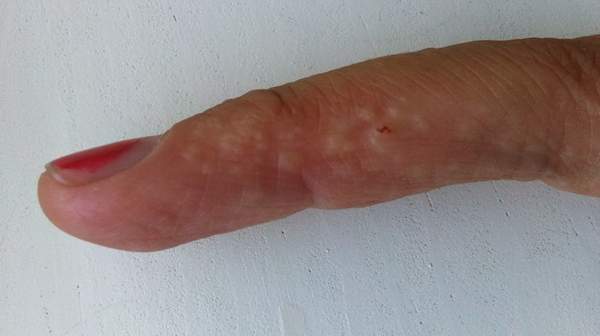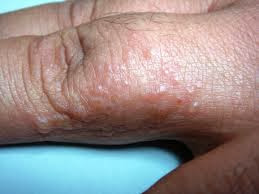What's in this article?
Dyshidrotic eczema, or dyshidrosis, is a skin condition in which blisters develop on the soles of your feet and the palms of your hands. Blisters are often itchy. Blisters develop on the soles of your feet and the palms of your hands. The blisters are usually itchy and may be filled with fluid. Blisters normally last for about two to four weeks and may be related to seasonal allergies or stress.
Causes of Dyshidrotic eczema
This blistering type of eczema is twice as common in women than men.
People are more likely to develop dyshidrotic eczema when:
- They are under stress
- They have allergies, such as hayfever
- Their hands are often in water or moist
- They do cement work or other work that exposes their hands to chromium, cobalt, nickel
The cause is unknown. The condition seems to appear during certain times of the year.
Symptoms of Dyshidrotic eczema
Small fluid-filled blisters called vesicles appear on the fingers, hands, and feet. They are most common along the edges of the fingers, toes, palms, and soles. These blisters can be very itchy. They also cause scaly patches of skin that flake or get red, cracked, and painful.
Scratching leads to skin changes and skin thickening. Large blisters may cause pain.
Exams and Tests for Dyshidrotic eczema
Your health care provider may be able to diagnose this condition by looking at your skin.
A skin biopsy may be needed to rule out other causes, such as a fungal infection.
If your doctor thinks the condition may be due to an allergic reaction, allergy testing (patch testing) may be done.
Treatment for Dyshidrotic eczema
Scratching only the condition worse.
- Anti-itch medicines taken by mouth, such as diphenhydramine (Benadryl) and loratiadine (such as Claritin), may help you stop scratching.
- Take an anti-itch medicine before bed if you scratch in your sleep.
Apply an ointments or creams to your hands at least two times per day, and after every hand washing.
- Heavy ointments are best. Petroleum jelly (such as Vaseline), mineral oil or vegetable shortening may be best but can be messy.
- Creams are thicker than lotions. Creams such as Eucerin and Lubriderm may be helpful.
Your doctor may prescribe steroid (or corticosteroid) ointments or creams. Other creams or ointments such as tacrolimus or pimecrolimus may also be used.
Your doctor may recommend the following if your symptoms are very bad:
- Steroid pills
- Coal tar preparations
- Phototherapy (ultraviolet light therapy)
Avoid frequent bathing, hand washing, and irritating substances, which can make itching worse.
Outlook (Prognosis) of Dyshidrotic eczema
There is no cure. Dyshidrotic eczema normally goes away without problems, but symptoms may come back. Excess scratching may lead to thick, irritated skin. This makes the problem harder to treat.
Possible Complications of Dyshidrotic eczema
- Pain and itching that limits the use of the hands
- Bacterial infection from scratching
When to Contact a Medical Professional
Call your health care provider if you have:
- Signs of infection such as tenderness, redness, warmth, or fever
- A rash that does not go away with simple home treatments
Alternative Names
- Dyshidrosis; Pompholyx







